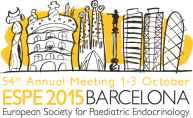
54th Annual ESPE
Barcelona,
Spain
01 Oct 2015 - 03 Oct 2015
Poster Category 3
Autoimmune
hrp0084p3-628 | Autoimmune | ESPE2015
Assessment of Ovarian Function and Reserve Based on Hormonal Parameters, Ovarian Volume, and Follicle Count in Euthyroid Girls with Hashimoto Thyroiditis
Kasikara Cigdem , Pirgon Ozgur , Demirtas Hakan , Dundar Bumin
hrp0084p3-629 | Autoimmune | ESPE2015
Early-onset Type 1 Diabetes and Multiorgan Autoimmunity in a Girl with Partial Monosomy 2q and Trisomy 10p
Bizzarri Carla , Matteoli Maria Cristina , Patera Ippolita Patrizia , Cappa Marco
hrp0084p3-630 | Autoimmune | ESPE2015
CTLA4 A49G and C60T Genetic Polymorphism in Croatian Children and Young Adults with Autoimmune Thyroid Disease
Putarek Natasa Rojnic , Kusec Vesna , Grubic Zorana , Knezevic-Cuca Jadranka , Ille Jasenka , Stajnkler Biserka , Jaksic Bruna , Dumic Miroslav
hrp0084p3-631 | Autoimmune | ESPE2015
Oocyte Cryopreservation in a Patient with Premature Ovarian Failure due to Autoimmune Polyendocrine Syndrome Type 2
Balsamo Claudia , Porcu Eleonora , Baronio Federico , Forchielli Luisa , Bazzocchi Antonia , Mazzanti Laura , Cassio Alessandra
hrp0084p3-632 | Autoimmune | ESPE2015
Thyroid Function and Autoimmunity in Children with Newly Diagnosed Type 1 Diabetes Mellitus
Niechcial Elzbieta , Skowronska Bogda , Gertig-Kolasa Anna , Krzysko Izabela , Stankiewicz Witold , Michalak Michal , Fichna Piotr
hrp0084p3-633 | Autoimmune | ESPE2015
Hypercalcaemia as an Indication of Adrenal Insufficiency in a Patient with Autoimmune Polyendocrinopathy–Candidiasis–Ectodermal Dystrophy
Dikaiakou Eirini , Vlachopapadopoulou Elpida-Athina , Anagnostou Elli , Panagiotopoulos Ioannis , Photinou Aspasia , Michalacos Stephanos
hrp0084p3-634 | Autoimmune | ESPE2015
Stevens Johnson Syndrome in a Case with Type 1 Diabetes Mellitus: Relation or Coincidence?
Akin Onur , Doger Esra , Demet Akbas Emine , Bakirtas Arzu , Camurdan Orhun , Bideci Aysun , Cinaz Peyami
hrp0084p3-635 | Autoimmune | ESPE2015
Radiologic Appearance is Important for Diagnosis of Autoimmune Hypophysitis
Sari Erkan , Yesilkaya Ediz , Akin Onur , Gursel Orhan , Sari Sebahattin
hrp0084p3-636 | Autoimmune | ESPE2015
Functional Status of the Thyroid Gland in Children with Diabetes Mellitus Type 1
Latyshev Oleg , Samsonova Lubov , Okminyan Goar , Kiseleva Elena , Lobanov Yuryi , Latyshev Dmitriy
hrp0084p3-637 | Autoimmune | ESPE2015
About a Case of Basedow-Graves’ Disease in a Infant
Bassaid M A , Bouriche K , Senouci D , Mazari W , Kaddour F Hadj , Ghellai F , Bendjelloul A , Medjahdi A , Berber N , Bendeddouche A S
hrp0084p3-638 | Autoimmune | ESPE2015
The Autoimmune Polyendocrinopathies in Children and Adolescents
Fedala Soumeya Nora , Haddam Ali El Mahdi , Ali Leyla Ahmed , Meskine Djamila , Chentli Farida



